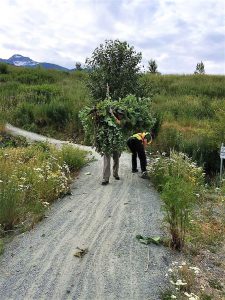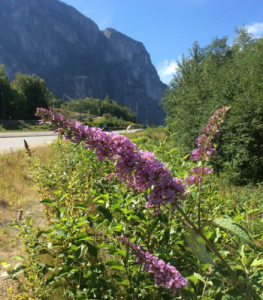There are so many invasive species in the Sea to Sky, if you want to have the biggest impact when removing, what should you do?
Please note: This blog post offers a small glimpse into why SSISC might remove certain species over others. There is a far more detailed page explaining how SSISC determines priority species.
1. Where is the plant growing?
Invasives that grow along frequently visited sites may have an easier time spreading because they can “hitchhike” onto humans, bikes, cars, or pets (Common Burdock is an infamous culprit of this).
Therefore, removing plants (or even just deadheading them!) along busy sites like the Valley Trail in Whistler, or along popular trailheads in the Sea to Sky, can make a big difference in reducing spread.

Invasive plants growing along roads and well travelled areas might spread faster.
2. How much harm is it causing?
It’s true, some plants are simply more damaging than others. Take Common Burdock and Curly Dock as an example: while both Common Burdock and Curly Dock are regularly found around Whistler, Curly Dock has a much smaller impact on the region compared to Burdock. That’s why SSISC spends time and resources treating Common Burdock (through the Banish Burdock program, for instance) but not Curly Dock.
Some invasive plants, like Giant Hogweed, are extremely dangerous and toxic to human health. These plants pose a greater risk to humans and are also prioritized for public safety reasons.
P.S. Don’t remove extremely dangerous plants like Giant Hogweed on your own! Please report sightings to SSISC.

Giant Hogweed is toxic to humans, so its removal is a high priority.
3. Is the plant already well established?
Some invasives are well-established in the Sea to Sky, while others are just arriving.
Many well-established species such as Butterfly Bush or Himalayan Blackberry have designated containment lines as a way to limit, control and monitor their spread. For more information, take a look at:

Butterfly bush is well-established in the Sea to Sky, and has a containment line just north of Squamish.
For species that are just arriving, eradication may still be possible. This makes them the highest priority for planned control programs at SSISC.
… And that’s it! Thank you for helping remove invasive species from the Sea to Sky region.
The three questions above are considerations that SSISC uses to determine where to focus our time and energy. We suggest anyone removing invasives species to consider these questions to have the most effective impact.
If you come across invasive species that you are unsure how to remove, please report the sightings to SSISC.
Do you have questions about how SSISC manages invasive species in the Sea to Sky?
Visit our Invasive Plant Management page or contact us!

